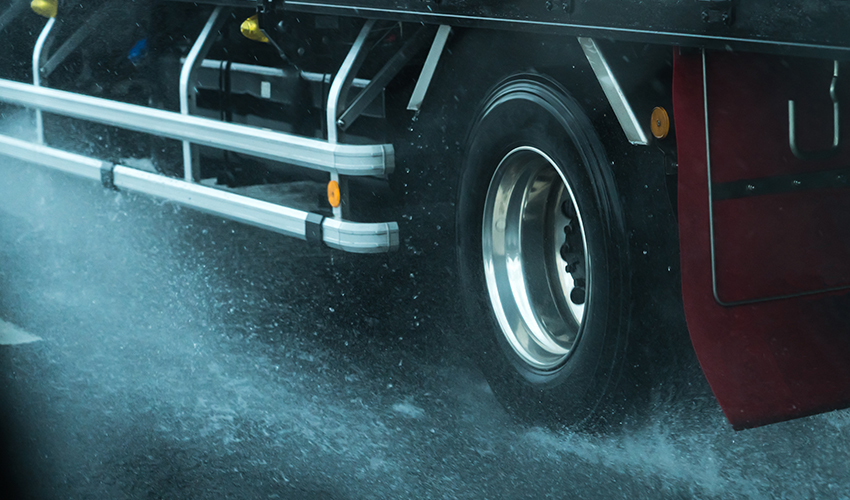Commercial Vehicle Hydroplaning (And How to Prevent It)
.jpg)
A safer fleet starts with prepared drivers. To reduce risk, prevent collisions, and improve performance, drivers must always be aware of potential hazards.
In adverse driving conditions, hydroplaning can be a real threat. In this guide we detail everything you need to know about a common driver question: what is hydroplaning, and how can I prevent it when driving a commercial vehicle?
What is hydroplaning for commercial drivers?
Also known as aquaplaning, hydroplaning is when your vehicle skids or glides uncontrollably over a wet surface and is often attributed to meteorological conditions (i.e. rain, snow, etc.). If you’ve ever lost control of a vehicle in wet conditions – even just for a second – then you’ve experienced hydroplaning.
The treads of commercial vehicle tires are designed to channel and disperse water from beneath them as they rotate and create friction with the road. Hydroplaning happens when the tires roll over more water than they can disperse. The pressure pushes the tires up, and the vehicle becomes separated from the road by a thin film of water.
This loss of traction results in diminished control and creates a sensation of spinning, sliding, or skidding. Although the effects typically last only a few seconds, hydroplaning can be scary, especially for commercial drivers carrying heavy loads or hazardous goods.
What causes hydroplaning in commercial vehicles?
We’ve already covered what causes hydroplaning in a scientific sense, and the degree of risk depends on several factors, including:
- The depth of water
- The condition of the road (i.e. are there ruts or a cross slope?)
- The width and grade of the road
However, we also need to consider vehicle and driver variables. There are several factors that fleets can monitor that reduce the chances of a hydroplaning incident. These include:
- Driving speed – Many tire manufacturers and fleet managers talk about hydroplaning speed. There is no universally agreed definition, but most industry experts agree that hydroplaning is more likely when vehicles exceed 35 mph in wet conditions.
- Tire condition – Regular servicing and preventative maintenance are required to ensure tires are replaced periodically, and that tire pressures and treads meet FMCSA regulations.
- Driver awareness – Department of Transportation (DOT) statistics suggest that nearly 1.235 million crashes each year are weather-related. Of those, 70% happen on wet surfaces and 46% during rainfall. So, drivers should always be conscious of weather conditions and adapt their driving style accordingly.
What to do when hydroplaning
Commercial drivers can avoid panic and regain control quicker by being more prepared. Here’s a list of steps to follow if a commercial vehicle begins to hydroplane:
- Don’t brake! – However instinctual it is, the vehicle will lose more traction and slide further out of control.
- Release the accelerator – Allowing the truck to slow down gradually.
- Turn into the skid – This sounds counterintuitive, but the vehicle will straighten out quicker if you mirror the skid with your steering.
- Keep steering corrections small – Sharp movements result in bigger skids.
- Eventually ease the brakes on – But only after you’ve regained control and tire contact with the road.
- Pull over – Hydroplaning can be intimidating, so allow yourself time to get your heart rate and breathing under control before you continue.
How to avoid hydroplaning in a commercial vehicle
Here’s a list of our top tips to avoid hydroplaning:
- Drive slower – The faster you drive, the less water tires disperse. In addition to reducing speed, consider driving in a lower gear for increased traction.
- Rotate, replace, and check tires regularly – DOT provides several commercial tire safety tips for fleet vehicles.
- Avoid cruise control - The cruise control sensor can’t reliably detect a vehicle’s speed to regulate engine output while a vehicle is hydroplaning.
- Steer clear of puddles and standing water – A good technique is to avoid outer lanes and drive in the tracks left by vehicles in front of you.
- Don’t make sharp steering adjustments, tight turns, or hard-braking maneuvers – All these will increase the chances of aquaplaning.
- Stop driving if you feel uncomfortable – It's better for a shipment to be late than never arrive at all, especially if continuing would put you or other road users at risk.
At Lytx, we offer a range of fleet management solutions to keep your vehicles and drivers safe. With an array of products, including the fleet tracking, a driver safety program, and our unique machine vision system and artificial intelligence (MV+AI) technology, you’ll have all the data you need to optimize for safety:
- Our driver-centric tools help detect risk and alert drivers to self-correct their risky behaviors.
- Our fleet safety solutions identify more than 64 million risk behaviors per year at an accuracy rate of more than 95%.
- With decades of experience, Lytx has developed programs that are associated with up to a 50% reduction in collisions.
Contact us today to find out more or schedule a demo.
